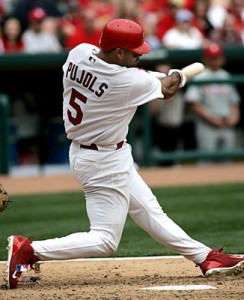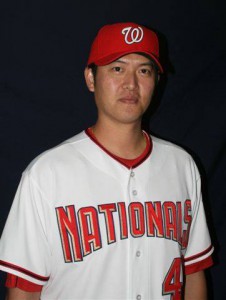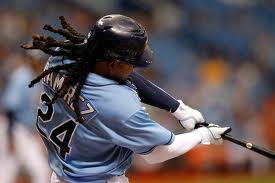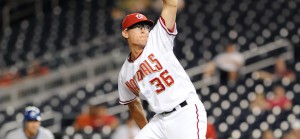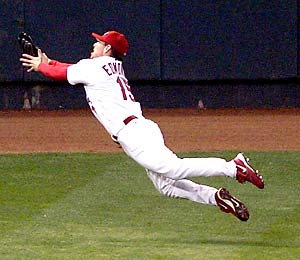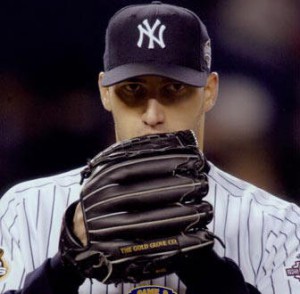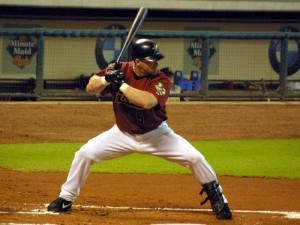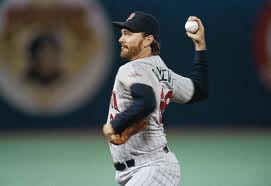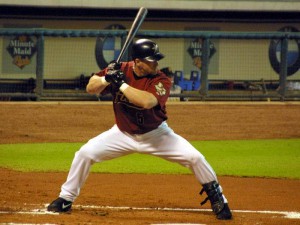
Can we please elect one of the best hitters of the last 30 years? Photo via bill37mccurdy.wordpress.com
On November 30th, the BBWAA announced the 2012 official Hall of Fame ballot. Let the cavalcade of Hall of Fame opinion pieces begin! (just a few early examples here, here, and here).
We all knew who was eligible for this ballot, thanks to the excellent work at baseball-reference.com. All the anticipated ballots are available for perusal along with statistical summaries of each player’s career and a few Bill James-inspired metrics created to give simple statistical measures of Hall-worthiness.
2012’s ballot is the last year before the Steroid accused superstars start becoming eligible (Bonds, Sosa, Piazza, and Clemens are all on the 2013 ballot for the first time, in addition to Schilling and Biggio) and the narrative about Hall of Fame voting turns to morality voting for the next decade or so. Gee, I can’t wait. All these players played in an era where there was no testing against PEDs and no MLB-specified rules against PEDs, but voters continue to penalize these players as if testing WERE being done, as if there WERE rules at the time they played. Meanwhile nobody talks about the PEDs that were prevalent for the last 30 years or so (amphetamines, or “greenies” in baseball parlance), and many players from the latter part of this decade freely talk of playing on speed. Frankly, it isn’t fair. We didn’t penalize Bob Gibson and put an asterick next to his accomplishments for pitching in a pro-pitcher, massive ballpark era did we? No; that was the game at the time. We don’t talk about how baseball fields used to be caverns with 480 foot distances and 30 foot walls, making triples far more common than homers. No; that was the game at the time. And frankly. the steroid era will eventually be remembered for what it was. Sometimes I think the anti-PED crowd is just a bunch of middle-aged white guys who are really peeved that an arrogant black ballplayer in Barry Bonds broke the cherished home run records of storied players from their youth (Babe Ruth and the far more likeable Henry Aaron). But I digress.
That being said, I like doing these Hall of Fame blog posts, if only because I usually disagree with the rest of the baseball blog-o-sphere on what really constitutes a Hall of Famer. I’ve been watching baseball long enough to form my own independent opinions on players and not depend on revisionist historians turning mediocre players into other-worldy hall-of-fame electees (see Blyleven, Bert and my stated opinions on his Hall-worthiness ahead of the 2011 ballot, and especially read the comment section where people refuse to address any aspect of Blyleven’s playing career and only use statistics to canonize him).
Notwithstanding that comment, I believe we’re being too parsimonious with Hall of Fame elections. Nate Silver from the NY Times wrote on this same topic in January of 2011, pointing out another interesting fact about the Hall of Fame (namely that roughly 13% of active major leaguers at various points in the 1930s and 1940s are now in the Hall). I’m not advocating that we need to be looking at 10% of current active major leaguers for the hall, but I am advocating that we be less “parsimonious” with the voting. This may seem contradictory to my opposing the candidacy of Blyleven; not so. There are a number of very deserving candidates who are not getting the votes they need. There seems to be several reasons for this:
- Players whose accomplishments in the pre-Steroid era are being discounted for the lack of “big numbers” (Larkin, Raines, Trammel, McGriff to certain extents).
- Players who toiled in the Steroid era are either users/suspected users (McGwire, Palmeiro), or are being caught in the steroid web (Bagwell).
- Players who are suffering from a conflict of opinion in the voter base for various reasons (Smith, Morris, Martinez).
I’m not sure how to resolve any of these situations frankly. But I’d hate to have these players languish on the ballot and age off of it and have to wait for some nebulous Veterans committee to enshrine them after they’re dead (see Santo, Ron). Some people advocate modifying the voting methodology, but in reality there’s no easy fix.
Back to the 2012 ballot: the only candidate eligible for the first time this year worth any discussion is Bernie Williams. For me, Williams was a nice player who retired early instead of facing the inevitable end of his Yankee career. He was part of a great core group of home-grown Yankees that formed the core of the late 90s dynasty team and will certainly be remembered as a great franchise player. That’s not enough; he was never the best player on his own team, he never sniffed an MVP vote and he never accumulated enough production to warrant being a focal point in the opposition. He had a great 5-year run … but if we were electing people on 5-year runs then Juan Gonzalez would already be in.
For the rest of the remaining candidates, I’ll borrow some from last year’s version of this post. I’m not going to go into major statistical analysis for each candidate (that analysis is freely available on most every major baseball blog site out there), but will state my opinion with a few choice links. On my hypothetical ballot I’d vote for:
- Jeff Bagwell: a career 149 OPS+. That’s a career averaging nearly 50% better hitting than the average MLBer. That he’s being lumped in with actual PED users without a shred of proof has become the latest hall of fame “cause” on the internet, starting with this excellent article accusing BBWAA writers of “plagiarism” (when I think he really means laziness, frankly). At least I support this one. Here’s an excellent case for Bagwell. You won’t find anyone penning a “case against” him that doesn’t claim that he’s a PED user without the proof.
- Jack Morris. The “anti” sabrematrician selection. Here’s a link to the most canonical case against Morris, as well as Joe Posnanski‘s anti Morris (and anti-other) rant. And here’s a case for Morris from former Washington Post writer Richard Justice, now with MLB, which goes a lot towards my way of thinking about the guy. Lots of people seem to be spending as much time arguing AGAINST him as they did arguing FOR Blyleven. I wonder why that is? Maybe there really just is a kind of pitcher who you had to see in context versus looking at his stats after the fact. Nolan Ryan “only” had a 112 ERA+ for his career and was barely a .500 pitcher, yet was a first ballot overwhelming hall-of-famer. There’s some disconnect here. For me, the vote for Morris is about the “feeling” of a dominant pitcher, just as Blyleven was about the “feel” of a mediocre pitcher, no matter what his eventual career stats looked like. For people who say this is fallacy, I say this: judgement of a player can not ONLY be done by looking at his stats. Morris had a reputation for “pitching to score,” though sabrematricians have attempted to debunk that pitching-to-score exists for some time (see this link on baseball prospectus, then note at the bottom that despite 3500 words he says “none of this proves it doesn’t exist.”) but he also had a reputation for being the “Best pitcher of the decade.” Bill James published a list of factors to consider, when evaluating a player’s candidacy, and the one takeaway I got from that list was (paraphrased) whether or not a player was the best on his team, the best in his league, a guy that the other team was afraid of. Morris was that, for a period of more than 10 years. His last two seasons took him from a 3.70 era to a 3.90 career era, and may have pushed him over the edge to his current stat-nerd polarizing stance. For me, he was THE pitcher of the 80s, led one of the most dominant teams ever (the 1984 Tigers) and pitched a 10-inning complete game win in one of the best games ever played. Those things stand for something, and should add up to more than a clinical analysis of his era+.
- Barry Larkin: lost in the shadow of Ozzie Smith for so long, that people forget that he was an excellent defender AND a great hitter. Long overdue for enshrinement. Here’s a pretty stat-heavy analysis FOR him.
- Tim Raines. Case for. Its hard to find cases against. Raines, like guys like Trammell and Larkin, played in the shadow of Rickey Henderson for so long and was always judged to be 2nd best. But his accomplishments, especially during the earlier part of his career, should be enough to get him into the Hall.
- Mark McGwire: He was a lock before the PED ensnarement. I say “ensnared” despite him using a completely legitimate supplement at the time. He didn’t try to hide it either.
- Edgar Martinez: I recently watched one of the games from the great series “MLB’s greatest games” of the last 50 years, and one of the games was the great game 5 playoff in 1995 between the Mariners and the Yankees. David Cone in that broadcast said that Martinez was “the best right handed hitter he ever faced.” And it struck me; Martinez indeed was one of the most feared hitters of his day. Look at his career: he didn’t play a full season til he was 27 and he played a ton of DH. He also retired with a career slash line above the mythical .300/.400/.500 targets. For those that discount his heavy use at DH I ask one simple question: if you think Martinez didn’t contribute that much by just being a DH, then how can you possibly support the inclusion of a one-inning relief pitcher/closer? Who do you really think contributes more, a DH with his 650 PAs or a relief pitcher with 60-some innings in a season? In reality, you can’t. It just takes an uber-DH like Martinez to press the issue.
Specific Names i’d leave off and why:
- Alan Trammell: I just don’t think he was a dominant enough player to warrant inclusion. I’d place him well behind his peers at shortstop for the ERA. There’s plenty of support for him in various forums though, with good arguments for him.
- Lee Smith: My tried and true argument; closers are incredibly overvalued, and especially closers with lifetime ERAs in the 3.00 range and with a career whip that’s closer to a league average than it is to dominant. Sorry; Smith isn’t a HoFamer for me.
- Larry Walker: the whole “he played in Colorado” angle probably isn’t as true as we think, but he still enjoyed a bump in his stats because of it. Otherwise he’s in the hall of Good, not the Hall of Fame.
- Rafael Palmeiro: its less about his idiotic stance in front of congress as it is about his method of “accumulating” his way to historic numbers. Much like the discussion we’ll eventually have about Johnny Damon (who is only a few hundred hits away from 3000 but clearly isn’t a transcending player), Palmeiro was always a good, solid guy but never that much of a game changer.
- Don Mattingly: I would love to vote for Donny Baseball, but being the Captain of the Yankees just isn’t enough (well, unless you’re a NY writer). Retired too early, not enough power for a first baseman, peaked at 25 and struggled into his 30s.
Let the comments calling me an idiot for supporting Jack Morris begin.
